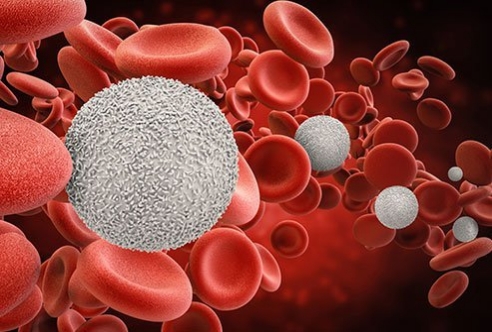What is Blood?
Blood is one of the most important components of life. It is a red colored fluid connective tissue that circulates throughout the body. It is slightly alkaline (pH 7.4), salty and viscous fluid. An average adult possesses around 4-6 liters of blood. Its main function is to transport oxygen and nutrients to various cells and tissues. It also plays an important role in defense mechanisms and immunity.

Composition of Blood
Blood has two main components - The fluid plasma (55%) and the formed elements i.e. blood cells (45%).
Plasma
Plasma is the liquid part of the blood. It constitutes 55% of the blood. It is a straw colored (pale yellow), slightly alkaline and viscous fluid. It contains 90-92% water, 7-8% proteins and 1% inorganic salts.
Function:
- Transports nutrients to the cells of various organs of the body and waste products to the kidneys, liver and lungs.
- It contains clotting factors which helps in clotting of blood.
Blood Cells
Blood cells constitute 45% of the Blood. It contains Erythrocytes (RBC's), Leucocytes (WBC's) and Thrombocytes (platelets).
1. Erythrocytes (RBC's)
RBC's (Red Blood Cell's) are circular and biconcave in shape and red in colour. They contains haemoglobin which helps in transport of oxygen to to various cells and tissues. It lacks nucleus and other major cell organelles for carrying oxygen. Its life span is of 120 days. In adults RBC's are produced in Red bone marrow and in foetus it is produced in liver and spleen.
RBC count: In males RBC count is 5.1-5.8 million/mm3 and in females RBC count is 4.3-5.2 million/mm3.
Function:
- Main function of RBC is to transport oxygen to various cells and tissues.
2. Leucocytes (WBC's)
WBC's (White Blood Cell's) are ameboid in shape and they are colourless cells. They are produced in bone marrow and found in blood and lymph tissue. They are part of the body's immune system.
WBC count: The WBC count in human is 5000-11,000 /mm3.
WBC's are classified in 2 main categories: Granulocytes and Agranulocytes.
a) Granulocytes:
Granulocytes cells contains granules (sacs) in their cytoplasm. They contribute 72% of total WBC and originated from bone marrow. These cells are involved in innate (inborn) immunity.
- Neutrophils (70%)
- Basophils / Cyanophils (0.5-1%)
- Acidophils / Eosinophils (1-3%)
b) Agranulocytes:
Agranulocytes cells do not contain granules (sacs) in their cytoplasm. They contribute 28% of total WBC and originated from lymphatic stem cells. These cells are involved in adaptive immunity.
- Monocytes (3-5%)
- Lymphocytes (25-30%)
Function:
- WBC's are involved in defense mechanism i.e protection of our body from diseases and illness by fighting against pathogens (disease causing organisms).
3. Thrombocytes (Platelets)
Platelets are small, oval (biconvex) shaped and yellowish coloured cells. They are also produced in bone marrow. These cells are involved in blood clotting, wound healing, homeostasis, etc. They secretes serotonin which acts as vasoconstrictor.
Platelet count: The normal platelet count in human is 2.5-4.5 lakh/mm3.
Function:
- Clotting of blood.
- Maintains stable and constant internal environment (homeostasis).
- Contracts blood vessels and increases blood pressure (vasoconstrictor).
Interesting Facts
- Single RBC contains 250 million molecules of haemoglobin.
Meanings
- Tissue: Group of cells having same structure and function.
- Blood clotting: Conversion of liquid blood into solid.
- Haemoglobin: The iron containing protein present in RBC's which binds to oxygen and transport to other cells and tissues.
- Foetus: An unborn human baby who is more than 8 weeks.
- Spleen: It is the largest lymphatic organ on left side of abdomen which filters blood.